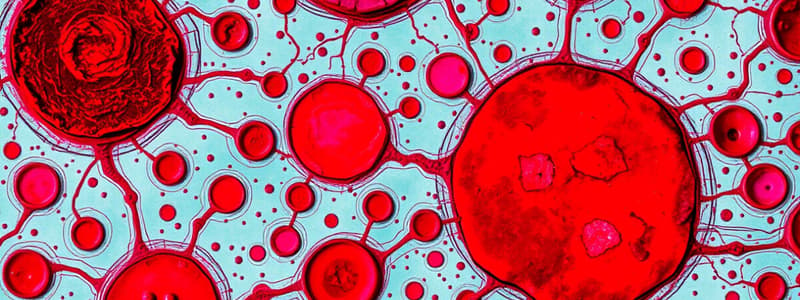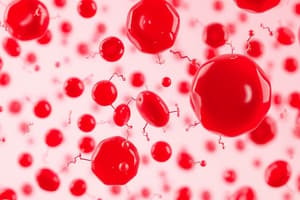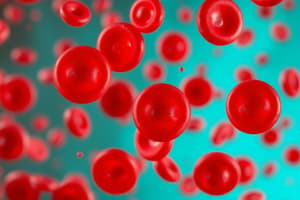Podcast
Questions and Answers
How much blood does the human body contain?
How much blood does the human body contain?
8 to 10 pints
What is a nutritive fluid flowing through the circulatory system?
What is a nutritive fluid flowing through the circulatory system?
Blood
What are platelets?
What are platelets?
Blood components that contribute to the blood clotting process
What is the study of tiny structures found in living tissues?
What is the study of tiny structures found in living tissues?
What is one reason estheticians should study body systems, organs, and tissues?
What is one reason estheticians should study body systems, organs, and tissues?
What is protoplasm?
What is protoplasm?
What is the process of cell reproduction called?
What is the process of cell reproduction called?
What is the sternum?
What is the sternum?
What is the fluid part of the blood that carries food and secretions to the cells and carbon dioxide from the cells?
What is the fluid part of the blood that carries food and secretions to the cells and carbon dioxide from the cells?
The origin part of a muscle is ____________________ to the skeleton.
The origin part of a muscle is ____________________ to the skeleton.
What are the structures composed of specialized tissues and performing specific functions?
What are the structures composed of specialized tissues and performing specific functions?
Why does the parathyroid gland regulate blood calcium and phosphorus levels?
Why does the parathyroid gland regulate blood calcium and phosphorus levels?
The pituitary gland is the most complex organ of the _____________________ system.
The pituitary gland is the most complex organ of the _____________________ system.
What organ in the endocrine system secretes enzyme-producing cells that are responsible for digesting carbohydrates, proteins, and fats?
What organ in the endocrine system secretes enzyme-producing cells that are responsible for digesting carbohydrates, proteins, and fats?
What are the secretions that the endocrine glands release directly into the bloodstream and that influence the welfare of the entire body?
What are the secretions that the endocrine glands release directly into the bloodstream and that influence the welfare of the entire body?
What is the primary function of the respiratory system?
What is the primary function of the respiratory system?
What is the primary function of the lymphatic/immune system?
What is the primary function of the lymphatic/immune system?
What is a primary function of the skeletal system?
What is a primary function of the skeletal system?
What is the primary function of the circulatory system?
What is the primary function of the circulatory system?
What is covered, shaped, and supported by the muscular system?
What is covered, shaped, and supported by the muscular system?
What body system is responsible for changing food into nutrients and waste?
What body system is responsible for changing food into nutrients and waste?
What is the primary function of the excretory system?
What is the primary function of the excretory system?
What is the primary function of the reproductive system?
What is the primary function of the reproductive system?
What is the body system that controls and coordinates all other body systems?
What is the body system that controls and coordinates all other body systems?
What is the connection between two or more bones of the skeleton?
What is the connection between two or more bones of the skeleton?
What body system serves as a protective covering for the body?
What body system serves as a protective covering for the body?
Connective, epithelial, muscle, and nerve are types of what found in the body?
Connective, epithelial, muscle, and nerve are types of what found in the body?
What are valves?
What are valves?
What bone forms the back of the skull above the nape?
What bone forms the back of the skull above the nape?
How many identical daughter cells are formed when a cell divides during mitosis?
How many identical daughter cells are formed when a cell divides during mitosis?
What body system affects the growth, development, sexual activities, and health of the body?
What body system affects the growth, development, sexual activities, and health of the body?
Where in the body does the spinal cord originate?
Where in the body does the spinal cord originate?
What are glands?
What are glands?
What is the importance of lymph?
What is the importance of lymph?
What binds the tissues of the body together?
What binds the tissues of the body together?
What carries messages to and from the brain and controls and coordinates all body functions?
What carries messages to and from the brain and controls and coordinates all body functions?
What organ circulates the blood?
What organ circulates the blood?
What do the kidneys do?
What do the kidneys do?
As one of the major body organs the brain has the function of __________________.
As one of the major body organs the brain has the function of __________________.
What is defecation?
What is defecation?
Which body system controls and coordinates all bodily functions?
Which body system controls and coordinates all bodily functions?
Which body system regulates temperature and produces vitamin D?
Which body system regulates temperature and produces vitamin D?
Which body system eliminates carbon dioxide as a waste product?
Which body system eliminates carbon dioxide as a waste product?
The kidneys and bladder are part of the system.
The kidneys and bladder are part of the system.
Which type of muscle will estheticians work with?
Which type of muscle will estheticians work with?
Which part of the muscle flexes but remains stationary?
Which part of the muscle flexes but remains stationary?
What muscle draws the scalp backward?
What muscle draws the scalp backward?
Which muscle causes wrinkles in the forehead?
Which muscle causes wrinkles in the forehead?
This muscle closes the eyes.
This muscle closes the eyes.
Which thin, flat muscle between the upper and lower jaws compresses the cheeks and expels air between the lips?
Which thin, flat muscle between the upper and lower jaws compresses the cheeks and expels air between the lips?
This muscle pulls down the corners of the mouth.
This muscle pulls down the corners of the mouth.
If you want to pucker up, you need to use the_________________ muscle.
If you want to pucker up, you need to use the_________________ muscle.
You can use this muscle to smile, but not grin.
You can use this muscle to smile, but not grin.
This muscle is used to grin.
This muscle is used to grin.
These muscles are used for chewing.
These muscles are used for chewing.
What are the three muscles of the ear called?
What are the three muscles of the ear called?
When you turn your head, you are using the____________________ muscle.
When you turn your head, you are using the____________________ muscle.
Which large, flat, triangular muscle covers the lower back?
Which large, flat, triangular muscle covers the lower back?
When you show someone your muscles on your arm, you are most likely showing them your_______________.
When you show someone your muscles on your arm, you are most likely showing them your_______________.
Which movement separates the fingers?
Which movement separates the fingers?
When you bend forward, which muscle movement are you using?
When you bend forward, which muscle movement are you using?
This movement is used to rotate the muscles.
This movement is used to rotate the muscles.
How does massage help the muscles of the hand?
How does massage help the muscles of the hand?
Why is it important as an esthetician to know about the muscles of the forearm?
Why is it important as an esthetician to know about the muscles of the forearm?
Why should estheticians have a thorough understanding of anatomy and physiology?
Why should estheticians have a thorough understanding of anatomy and physiology?
Cells are made up of a colorless, jellylike substance called ______________ in which food elements such as protein, fats, carbohydrates, mineral salts and water are present.
Cells are made up of a colorless, jellylike substance called ______________ in which food elements such as protein, fats, carbohydrates, mineral salts and water are present.
The principal parts of the cell include the protoplasm,_______________________.
The principal parts of the cell include the protoplasm,_______________________.
Found in the center of the cell, the ___________________ plays an important role in cell reproduction.
Found in the center of the cell, the ___________________ plays an important role in cell reproduction.
What is the study of structures of the human body and substances these structures are made of?
What is the study of structures of the human body and substances these structures are made of?
What is the study of the functions and activities performed by the body structures?
What is the study of the functions and activities performed by the body structures?
This movement is used when muscles turn inward.
This movement is used when muscles turn inward.
Which movement draws the fingers together?
Which movement draws the fingers together?
This movement is used when muscles straighten.
This movement is used when muscles straighten.
What is the study of structure, function, and pathology of the nervous system?
What is the study of structure, function, and pathology of the nervous system?
The ____________ connects the spinal cord to the brain.
The ____________ connects the spinal cord to the brain.
The nervous system is divided into ______ main subdivisions.
The nervous system is divided into ______ main subdivisions.
Which nervous system consists of the brain, spinal cord, spinal nerves, and cranial nerves?
Which nervous system consists of the brain, spinal cord, spinal nerves, and cranial nerves?
Which nervous system connects the peripheral parts of the body to the central nervous system?
Which nervous system connects the peripheral parts of the body to the central nervous system?
Which nervous system controls the involuntary muscles?
Which nervous system controls the involuntary muscles?
Estheticians are primarily concerned with nerves ______, ________, and _________.
Estheticians are primarily concerned with nerves ______, ________, and _________.
There are _____ pairs of cranial nerves arising from the base of the brain and the brain stem.
There are _____ pairs of cranial nerves arising from the base of the brain and the brain stem.
This nerve reacts to a stimulus that involves movement of an impulse from a sensory receptor along the sensory nerve to the spinal cord and a responsive impulse back along a motor neuron to a muscle, causing a reaction.
This nerve reacts to a stimulus that involves movement of an impulse from a sensory receptor along the sensory nerve to the spinal cord and a responsive impulse back along a motor neuron to a muscle, causing a reaction.
This nerve affects the skin of the forehead, upper eyelids, and interior portion of the scalp.
This nerve affects the skin of the forehead, upper eyelids, and interior portion of the scalp.
This nerve affects the muscles of the chin and lower lip.
This nerve affects the muscles of the chin and lower lip.
This nerve affects the upper part of the face.
This nerve affects the upper part of the face.
What is the largest cranial nerve?
What is the largest cranial nerve?
This nerve affects the external ear and skin above the temple, up to the top of the skull.
This nerve affects the external ear and skin above the temple, up to the top of the skull.
This nerve affects the skin of the lower eyelid, side of the nose, upper lip and mouth.
This nerve affects the skin of the lower eyelid, side of the nose, upper lip and mouth.
This nerve affects the membrane and skin of the nose.
This nerve affects the membrane and skin of the nose.
This nerve affects the skin of the lower lip and chin.
This nerve affects the skin of the lower lip and chin.
This nerve affects the point and lower side of the nose.
This nerve affects the point and lower side of the nose.
This nerve affects the skin of the forehead, scalp, eyebrow, and upper eyelid.
This nerve affects the skin of the forehead, scalp, eyebrow, and upper eyelid.
This nerve affects the muscles of the upper part of the cheek.
This nerve affects the muscles of the upper part of the cheek.
This nerve affects the muscles of the mouth.
This nerve affects the muscles of the mouth.
These nerves affect the side of the neck and the platysma muscle.
These nerves affect the side of the neck and the platysma muscle.
This nerve affects the muscles of the chin and lower lip.
This nerve affects the muscles of the chin and lower lip.
This nerve affects the muscles behind the ear at the base of the skull.
This nerve affects the muscles behind the ear at the base of the skull.
Flashcards are hidden until you start studying
Study Notes
Blood and Circulatory System
- The human body contains 8 to 10 pints of blood.
- Blood serves as a nutritive fluid in the circulatory system.
- Plasma is the fluid part of blood, transporting nutrients and waste, including carbon dioxide.
Cellular Biology
- Platelets are blood components crucial for the blood clotting process.
- Protoplasm comprises the jellylike substance within cells, containing essential food elements.
- Mitosis is the process of cell reproduction, resulting in two identical daughter cells.
Anatomy and Organs
- The sternum is a flat bone that supports the ribs.
- Organs are specialized structures composed of tissues performing specific functions.
- The nervous system controls and coordinates all body functions.
- The endocrine system regulates growth, development, and health through hormones.
Glands and Hormones
- The pituitary gland is the most complex organ of the endocrine system.
- The pancreas secretes enzymes for digesting carbohydrates, proteins, and fats.
- Hormones are secreted by endocrine glands and influence overall body welfare.
Systems and Functions
- The primary function of the respiratory system is breathing; the lymphatic/immune system protects against disease.
- The skeletal system provides a physical foundation, while the circulatory system moves blood throughout the body.
- The digestive system transforms food into nutrients and waste, and the excretory system eliminates waste.
- The reproductive system perpetuates the human race.
Muscular System
- Skeletal tissue is shaped and supported by the muscular system.
- The origin of a muscle attaches to the skeleton and remains stationary during movement.
Neurology
- Neurology is the study of the nervous system's structure, function, and pathology.
- The brain connects to the spinal cord via the brainstem.
- The central nervous system (CNS) includes the brain, spinal cord, cranial nerves, and spinal nerves.
- The autonomic nervous system controls involuntary muscles.
- There are 12 pairs of cranial nerves affecting various facial areas.
Muscles of the Face and Neck
- The occipitalis muscle draws the scalp backward; the frontalis causes forehead wrinkles.
- Orbicularis oculi closes the eyes, while buccinator compresses the cheeks.
- Muscles like the masseter and temporalis are used for chewing.
- Sternocleidomastoid muscle enables head rotation; latissimus dorsi covers the lower back.
Nerve Functions
- Reflex nerves react to stimuli causing muscle movement.
- The maxillary nerve affects the upper part of the face; the mandibular nerve affects the chin and lower lip.
- Infraorbital nerve affects the skin around the lower eyelid and upper lip, while nasal nerve impacts the nose.
Important Movements
- Abduction separates fingers, while adduction draws them together.
- Flexion occurs when bending forward and extension occurs during straightening.
- Supination is a rotational movement, while pronation turns muscles inward.
Importance for Estheticians
- Understanding anatomy and physiology helps estheticians assess the effects of services on tissues and systems.
- Knowledge of forearm muscles is important for maintaining good body mechanics.
- Massage aids in maintaining pliability in hand muscles.
Studying That Suits You
Use AI to generate personalized quizzes and flashcards to suit your learning preferences.




